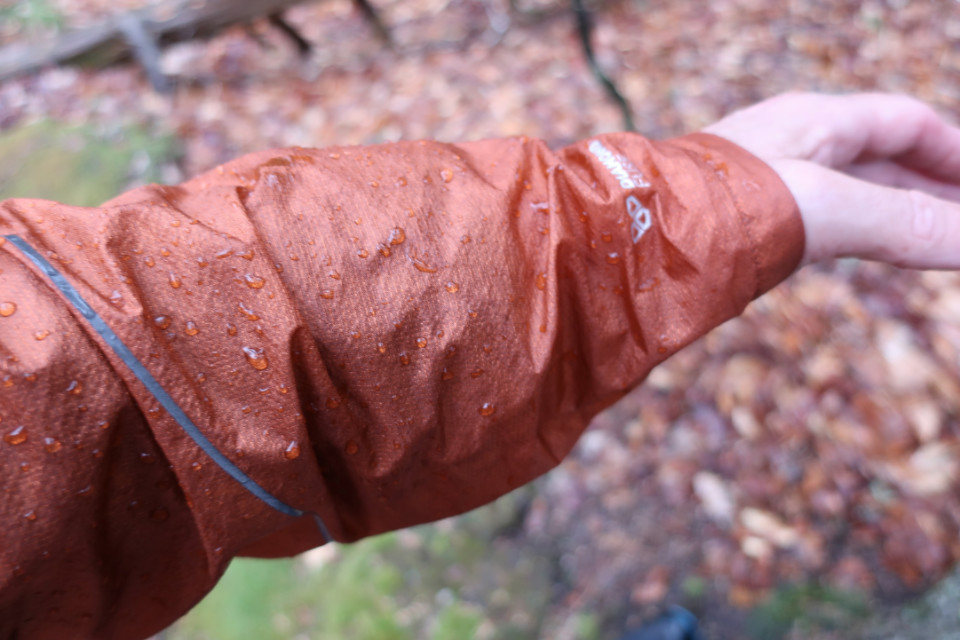
Waterproof/breathable rain jackets are coated with a polymer called DWR (Durable Water Repellency) that makes rain bead up and roll off the exterior surface of the jacket. Many, but not all, DWR coatings are based on fluoropolymers that have a fluorine atom at one end that is highly hydrophobic. Water is repelled by the fluorine atoms resulting in beading which makes the water roll off without wetting the jacket’s outer fabric.
Reduce Abrasion
Over time, that DWR coating wears off in areas of high wear and abrasion. If you’re a hiker or backpacker, this includes all of the places where a backpack rubs against a waterproof/breathable jacket: under the shoulder straps, along the back, under the hip belt, and inside the arms if you use trekking poles.
Other high wear areas include the ends of your sleeves, the inside of the neck, and alongside zippers. The DWR coating can also be degraded if it rubs up against other items in your backpack, especially if you frequently stuff your rain jacket loose into your pack.
It follows that you can extend the life of the DWR coating by reducing the time that your rain jacket is in contact with your backpack by wearing other garments, such as a wind shirt, or an insulated hoodie, instead of a rain jacket to protect yourself from the wind or to stay warm. Storing your rain jacket in its pocket if it’s stuffable that way or in a separate stuff sack will also reduce the abrasion that results from stuffing it into your backpack loose.
Reactivate the DWR with Heat
While you can restore the DWR coating on a waterproof/breathable rain jacket with an aftermarket product like Nikwax or Grangers, it will never be as good as the factory DWR coating when the jacket is new. During the manufacturing process, high heat is used to adhere the DWR coating to the jacket’s external fabric and to optimally align the fluorine atoms in the DWR coating to repel water.
You can reproduce this effect in a clothes dryer when you notice that rain is soaking the exterior fabric of your jacket, called wet-out, instead of beading up and bouncing off. The density of the DWR coating won’t be as high as when the jacket was new, but at a minimum, all you have to do is to throw the jacket into a drier to improve the effectiveness of the DWR coating. You can get an even better result if you wash the jacket beforehand with a special performance soap like Nikwax Tech Wash that doesn’t leave any residue like conventional detergent.
Reapply DWR Coating
If washing and drying your rain jacket doesn’t improve the effectiveness of the DWR coating, you can reapply the DWR coating with an aftermarket product like Nikwax TX.Direct Spray-on or Revivex Durable Water Repellent Spray. Some aftermarket DWR coatings, like these two, do not require heat to be activated, but others do. Read and follow the directions. You will usually want to wash the jacket first using a performance soap like the Nikwax Tech Wash described above first, before reapplying the DWR coating because dirt, grime, sweat, etc. can interfere with its uptake.
Spray-on DWR products are preferable to liquids that you pour into a washing machine because you can control where the coating is applied. For example, you don’t want to spray DWR on the inside of a rain jacket because it will repel and trap water vapor in the jacket so it can’t get out.
How often should you reapply the DWR Coating to a waterproof/breathable rain jacket? Arcteryx is one of the few manufacturers that provides clear directions on this front. They recommend reapplying the DWR coating after 10-12 heavy uses of a rain jacket. By heavy, they mean when used for active sports like hiking or backpacking and not for more casual use around town. If you’re a frequent hiker, that may well require several applications per year or more.
 SectionHiker.com Backpacking Gear Reviews and FAQs
SectionHiker.com Backpacking Gear Reviews and FAQs